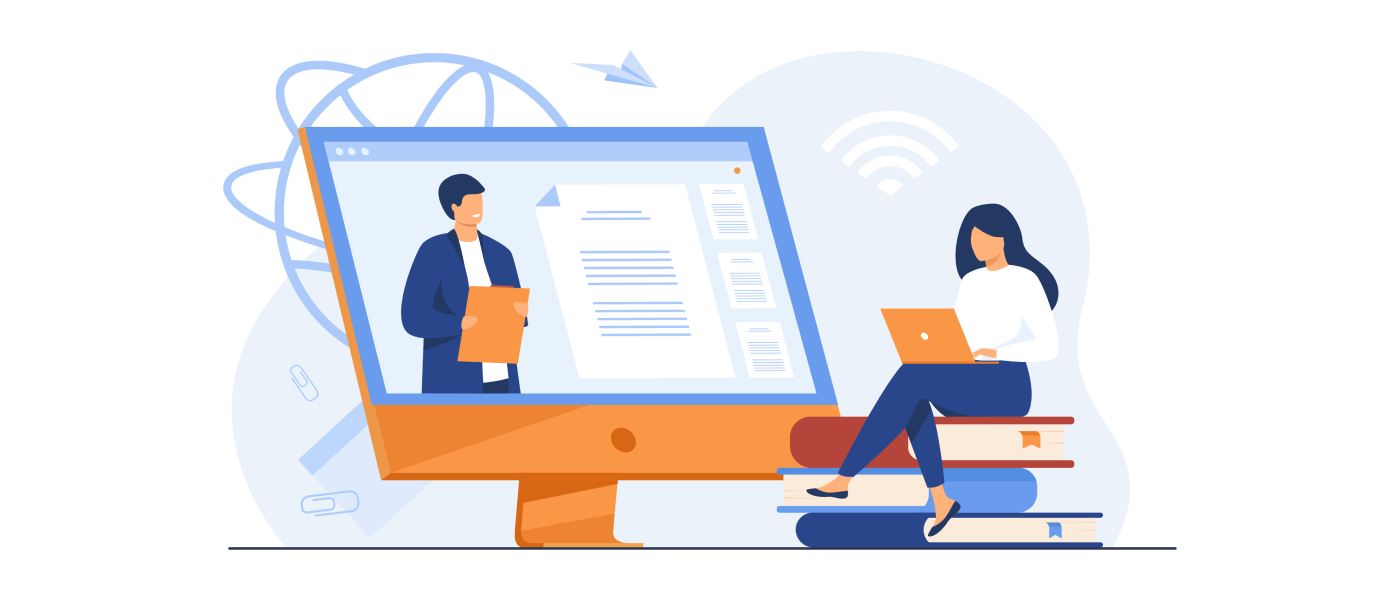
As per definition by US Dept. of Interior Bureau of Indian Education, an LMS (Learning Management System) is an online integrated software for creating, delivering, tracking, and reporting educational courses and outcomes.
This definition quite accurately describes an LMS.
The original use case of LMS was for higher education sector and has been used generally by industrial organizations to identify technical gaps in their workforce, training them with the modules which shall make their workforce much better acquainted with the industrial requirements. However, recently LMS are being used by educational institutions as well.
How does LMS work?
LMS (Learning Management System) works on SaaS (Software as a Service) model, LMS supports the ability to add, administrate and deliver educational courses.
What makes LMS stand out?
- You can upload all kinds of materials in LMS, i.e., videos, documents, PDFs etc. to name a few.
- As an instructor, you can upload your course whether all in one go, or you can go for parts of a course. You can take live sessions as per your as well as students’ convenience.
- The discussion boards present inside LMS can provide valuable insight to everyone and can act as a common forum to discuss new ideas.
- You can also conduct a Live Q&A session through it where people can ask their queries. An FAQ can also be uploaded which helps a novice or somewhat experienced person get their queries resolved.
- The onboarding of new employees becomes a lot easier for companies as they can train their employees about all the required technologies, products or services that are expected of them also tracking employee’s progress becomes a lot easier.
- LMS provides very smooth integration across all the departments in case of organization.
- LMS makes communication between parents and teachers a lot easier as parents can contact teachers through the LMS solution easily and vice versa.
- Assignments can directly be uploaded in LMS from there, teachers can grade students’ work.
- LMS makes it easier for employees to attain certifications in new areas which shall be helpful to them which in turn benefits the organization.
How LMS helps Organizations as well as Educational Institutions
In case of Organizations
- LMS provides a way to cut down the time required to train their staff and onboarding of new staff.
- It helps keep a check on employee’s progress in training and help maintain an equal standard across various departments as well as subsidiary companies in case of very large organizations.
- It makes onboarding of employees easier as new employees come to know about the technologies they shall be working on, compliance rules they are expected to follow etc. thus making this process quite seamless.
- LMS helps train employees in various verticals across different departments and can be beneficial in case of large companies where they might have multiple subsidiary companies, thus the training modules can be streamlined in parent as well as subsidiary companies.
- LMS can also help develop better sales and communication skills of employees even located at far away locations as training material taught by seasoned employees can be used as a guideline for new as well as employees who aren’t that good in these skills.
- LMS can act as a Knowledge Base, where employees can refer to older offerings by the organization thus, they can better serve their customers, clients.
- LMS can provide a way to upskill employees with remote learning which has now become increasingly important because of the COVID-19 pandemic.
In case of Educational Institutions
- LMS provides an ability for streamlining communication between parents, teachers, and students.
- LMS helps students better understand subject matter. Thereby, increasing their learning outcomes.
- LMS can help reduce administrative costs as the need to keep physical records decreases.
- LMS can also help students have better communication with each other in scenarios where schools were closed due of the pandemic.
Though, LMS is being used in both organizations as well as educational institutions. There are some fundamental differences in how LMS is used across organizations and across educational institutions which are illustrated below.
LMS in Organizations
Here, the general aim is that employees can pick up practical skills which shall be helpful to them as well as the organization.
- In case of organizations, the main idea behind is that since freshers and even older employees need knowledge about new technologies so by teaching them, these employees can be a value addition to the company. i.e., ROI (Return On Investment) is the primary goal.
- In Organizations, progress is monitored through tracking the number of hours spent on learning as well as completion certificates employees get.
- In an ever-changing world, where new technologies are being developed everyday as well as companies launching new products and services, it is logical that the content gets updated at the LMS platform quickly and quite regularly so that everyone can benefit out of it.
- LMS in organizations can provide a common place i.e., a discussion board where employees can discuss a new strategy they implemented while working to get a new client, a new type of code that they wrote which helped decrease the complexity and runtime of code. Thereby, these boards can be beneficial for the organization as they promote inter as well as intra department co-operation.
- The courses scheduled are generally short in duration as employees generally do not have a lot of time at their hand and are busy with their respective job roles and the duties associated to these. The courses here often, take a few hours to complete.
LMS in Educational Institutions
Here, the general aim is to make students have a better and deep understanding of the subject matter.
- The main philosophy behind using LMS in case of educational institutions is that the theoretical knowledge of the students increases and can understand each core term pertaining to the subject.
- In case of Educational Institutions, learner’s progress is measured through grading system. Parents can see their child’s attendance across various subjects and can also come to know their child’s grades in various subjects.
- Since in educational institutions, the content is generally theoretical as well as deepen the understanding of the subject hence content updation takes place slowly.
- LMS also helps students as it can act as a platform where they can create student groups for doing project work together, discussion boards can be created where students can discuss various topics thus leading to better co-operation between them especially in uncertain times, like the pandemic.
- In case of Educational Institutions, the study material that is available for students for that particular year, semester etc. acts as the knowledge base.
- The courses scheduled here are generally as per years, semesters, trimesters etc. as per the needs of the institution. They should also consider the time of holidays, exams and periods that are allocated to them.
Further, there are 6 major categories across which LMS are divided:
- Installed and Cloud Based LMS
- Free and Commercial LMS
- Open Source and Proprietary LMS
Installed vs Cloud Based LMS
LMS solutions of both Installed and Cloud Based are available in the market. However, Installed LMS have been losing share in the market for the simple reason being they are much difficult to maintain than their Cloud Based counterparts.
Cloud Based LMS have been steadily gaining market share as they are easier to maintain. Though the initial cost for Installed may have been low as compared to Cloud Based. However, in the long run Cloud Based are much easy to add or remove features.
Free vs Commercial LMS
There are a few free and commercial LMS out there. Some examples of free LMS, include: EdApp, CourseSites, ATutor,Moodle. Some examples of commercial LMS, include: Schoology, EthosCE.
Free LMS are generally for those people who are on a tighter budget to get LMS and can later deploy developers, testers etc. to add features as per your need.
Commercial LMS comes with a lot of features in-built some that you may not even require at that time. However, these features could easily be useful in future. Also, commercial LMS make compliance of company regulations a lot easier.
Open-Source vs Proprietary LMS
Open- Source is the norm of almost everything, from OS, software and even LMS. Some examples include: Moodle, LearnDash (A WordPress LMS Plugin),LearnPress (A WordPress LMS Plugin) etc.
If you want to create an LMS which is cost-effective you can always go for Moodle, LearnDash or LearnPress to initially use it to create your LMS. The codebase is open source however you can customize the internal interface and add features as per your liking.
The advantage of using Open-Source LMS are simple: any one can use it to upload their material, since these are already established you need not go through the process of establishing these.
However, Open-Source LMS make compliance a lot more difficult. In case of Proprietary LMS, this becomes a lot easier as the company itself maybe managing or they might have a contract with another company who manages it making everything in LMS completely compliant as per company guidelines.
In conclusion, LMS can help organizations, students, individuals almost anyone who wants to leverage it to train employees, help students understand subjects better and become better learners, make money by selling courses and what not. The use-cases of LMS are end-less. You could either decide to use a Free, Open Source LMS platform for your needs or you could get a custom LMS developed as per your needs.








